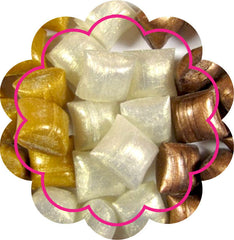Give Credit Where Credit Is Due (or How to Play Nice in the Creative Sandbox)
- Anna Weisend
- 14 Nov 2018
It is rough being an artist.
Whether your medium is paint, or thread, or clay, or sugar, you are always being judged. There is always pressure to be original. There is pressure to be the latest and greatest. Add today’s tension to self-promote- always on every social media platform to prove you have the goods- and it can be overwhelming.
As an artist, you also have the need to protect your work so that people aren’t using it for free or misrepresenting themselves with your creations. There are unscrupulous people in the world but oversensitivity or misplaced loyalty can misdirect a lot of good intentions.
This behavior can create a lot of infighting in creative circles, which is always ugly and never productive. It is present in our little sugar world: People claiming work for their own, people going so far as to plagiarize teaching instructions, people using someone else’s hard work as a stepping stone for their benefit. Additionally, there are a lot of claims that aren’t really as simple or one sided as they appear or flat out made from an uneducated point of view.
Just for a moment, let’s all call a ceasefire and remember and reflect on some important points that sort of fall in a gray area.
Consider this:
The Person Famous For A Technique, Invention, Or Idea Is Not Usually The Person Who Came Up With It First.
- Joseph Lambeth did not invent the Lambeth technique. He only put his own spin on it and published a book. P. Borella wrote about similar piping techniques 24 years earlier. Again, Borella only wrote the book, these techniques had been passed down for years from decorator to decorator. Lambeth was just the marketing genius of his time.
- Davinci was the first one to document the design of a flying machine in 1485. But according to Greek mythology, Icarus already had the idea that man could fly, until he failed by flying too close to the sun and his wax wings melted. Many people devised different flying machines over the centuries (Hot Air Balloons 1783, Blimps 1852, Zepplins 1900) but it wasn’t until 1903 when the Wright brothers were successful with an airline flight.
- Who came up with “Rock ‘n’ Roll”? Alan Freed coined the term but as a genre its roots go back to R&B, “race” music, “hillbilly” music, and country music of the 1930’s and 40’s. It was an evolution, it just didn’t show up all of a sudden one day. So can we really know who invented Rock ‘n’ Roll?
There Are Fewer Original Ideas Than You Think
- Emojis are new but not new…they are strikingly similar to hieroglyphics which have their primitive roots in cave drawings…all stemming from the desire to communicate.
- That beautiful Lambeth piping? It is very reminiscent of wood and stove carving and plaster work from years and centuries gone by.
- Both bead work and blanket weaving have similar motifs in tribes on separate continents in an era where traveling was uncommon. The medium and its limitations played a part in its creativity.
- Jackson Pollack is famous for his splatter painting. Kids and people who throw paint brushes had been playing with that concept for centuries.
Life And Creativity Are Not Fair
- Have you ever had a great idea only to find out someone beat you to the punch? Someone else had that same great idea.
- Have you ever tried a new technique only to have it highly criticized as a bad idea only for it to surface as a trend 10 years later with a lot of hoopla and ooohs and aaahs surrounding it? It’s enough to make you cry. You are just ahead of your time.
- Have you ever tried a new color combination only to hear that it is unacceptable or ugly? 25-30 years ago it was unheard of to put black on a wedding cake. Now it is elegant and chic.
- Once ideas are out in the world, you can’t get them back. Ever have a great idea but you weren’t ready to run with it but someone else thought it was wonderful and took off with it? Is it fair that they were ready and you weren’t?
- Sometimes, despite your best efforts, you just don’t have enough information. You think that you know where something originated and it turns out that someone in another part of the world, or someone who straddles the line of sugar art and pastry has done it before. You just don’t know what you don’t know.
Rethinking It:
Before you try to tear someone down about “stealing ideas” and “ripping people off”, you need to try to wade through the gray areas and find a respectful place for everyone to land on the subject.
Be Practical
- Everyone is using someone else’s ideas. So come to terms with that. Basics will always be basic. Techniques can be tweaked and improved but in piping a snail trail there is not much new to “invent”. A botanical replica of a rose can only be improved on so much before Mother Nature laughs. All the colors in the world already exist, it’s discretionary how they are used.
- Give credit where credit is due. Whenever possible. As often as possible. If you learned it from a book or a video or a person it is ok to let people know where that knowledge came from. If you got inspiration from someone or somewhere else, that is ok to let people know as well.
- If something inspires you, do your best to re-envision it or refashion it in your own style.
- Do NOT blatantly steal actual class curriculum. If you want to teach it, then you put in the work.
- Do NOT pass off someone else’s work as your own.
- If someone shares an idea in confidence or asks for your feedback do NOT turn around and try to implement it first. Have a little bit of integrity.
- If you feel like you have a great idea then be ready to run with it as far as you want to go. Don’t put it out there and expect everyone to ignore such an obvious strike of genius.
Be Gracious
- If there is a new idea you want to teach or promote or create a product for, it is professional courtesy to ask the originator if there is a way you could do so without stepping on their toes. And if they happen to say no, if they don’t move on it after a reasonable amount of time, then take initiative to go ahead.
- If someone has a new spin on something you are doing, if it isn’t competing directly with what you have in the works, be gracious enough to give them your blessing.
- Make sure you have all the facts and researched the subject extensively before you lay down allegations before someone.
Be Zen
Ideas are everywhere. In the book, Big Magic, Creative Living Beyond Fear, the author, Elizabeth Gilbert, posits that ideas are energy soaring around the universe waiting to be manifested. When the idea sits too long in a waiting state, it goes on to the next person until someone does something with it. That theory, upon reflection of many experienced people, has shown evidence that it is true.
[Author’s note: Ms. Gilbert states this more eloquently and in more detail than in this short summary, specifically in the chapter entitled Enchantment. I highly recommend reading the entire book.]
If we are not ready for an idea, the idea will go searching for someone is willing to fully embrace it. We all have a lot on our plate. We cannot always act on every idea we have. So we have to let that idea go to someone who is ready, willing, and able at that exact time to tend to it.
With All That Said…
In your work always be kind, be honest, and be informed. Less infighting and more focus equals more ideas coming to fruition.




